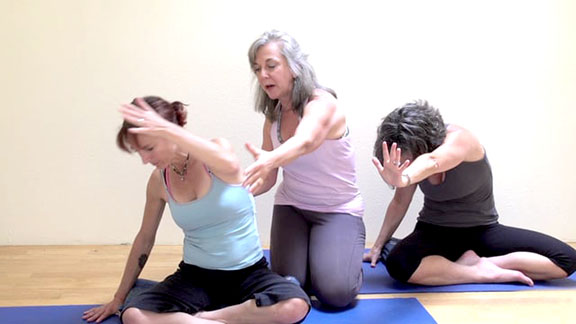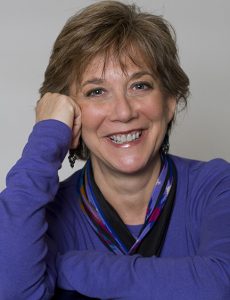 Robin Rothenberg is an internationally respected Yoga therapist who runs acclaimed training programs for teachers and therapists. She draws deeply from the authentic lineage of Yoga, while also incorporating a contemporary understanding of mind-body medicine, the result of her years of study in western science. She acts as a bridge, between these two seemingly disparate worlds, facilitating clients and teachers in breaking free of habits that are debilitating and developing a clear plan of action to help themselves find equilibrium and a greater sense of confidence and well-being. She discusses her role as an educator in this interview with Dr. Sevika Douglass.
Robin Rothenberg is an internationally respected Yoga therapist who runs acclaimed training programs for teachers and therapists. She draws deeply from the authentic lineage of Yoga, while also incorporating a contemporary understanding of mind-body medicine, the result of her years of study in western science. She acts as a bridge, between these two seemingly disparate worlds, facilitating clients and teachers in breaking free of habits that are debilitating and developing a clear plan of action to help themselves find equilibrium and a greater sense of confidence and well-being. She discusses her role as an educator in this interview with Dr. Sevika Douglass.
Integral Yoga Magazine (IYM): What led to your practice of Yoga therapy?
Robin Rothenberg (RR): I had been teaching a gentle therapeutic class for a number of years and I loved adapting the practices to meet the people who were in my classes. I thought, Why do I only do this in my therapeutic class? I was increasingly drawn to understand how to therapeutically adapt Yoga for everyone who came to my classes. I could see the immense value of adapting Yoga to the physiological and emotional issues that are a part of so many of our lives. I wanted to help people uncover Yoga as an internally driven process.
Asanas are powerful. People come to our classes from sedentary lives and we need to be able to prepare our students for the full benefits of Yoga. I saw the need for conscientious training in Yoga therapy. Many teachers know how to teach the poses, but they can’t adapt the postures to the needs of the people. As Yoga therapists we need to be really adept at working with people. We need to set a higher bar for Yoga teachers.
IYM: A key point in your trainings is the difference between treating health issues and treating the person who is living with health challenges.
RR: The allopathic view is that the doctor or other health care provider fixes the problem. In Yoga, we don’t fix problems, we hold people in their wholeness. This means recognizing the physical, emotional, intellectual, relational, and spiritual dimensions of people’s lives. A person might come to me with back pain, but that is just one element of who they are. If I fixate on their back pain, I may miss what that person is calling for on a deeper level. Perhaps they do have a structural problem that contributes to their pain, but a deeper issue is that they hate their job.
By the time I begin seeing someone, they’ve usually seen lots of other health-care providers: their primary care physician, maybe a psychotherapist, or a chiropractor, or an acupuncturist. Each of these individuals holds a piece of who this person is and understands one aspect of why this person is in need of healing. A Yoga therapist sees the whole person with his or her history, dreams, and aspirations.
IYM: Many of us know what we need to do to be healthy, but can’t take the steps to transform our knowledge into practice.
RR: Habits are difficult to change because so much of what we do is unconscious; 40 percent to 60 percent of what we do is habitual. Yoga is about bringing the unconscious to our awareness. When people come to see me, they are aware that they are suffering but they are not aware of why they are suffering. My job as an educator is to help my students see where they are stuck, how their unconscious behaviors are affecting their lives.
When someone comes in with pain, they often have an acceptance of it. They might say, “My Dad has a bad back too,” or “I have to stay in my job,” or “I’ve always had headaches.” There is resignation. Resignation is a sign that we are operating from an unconscious place. Perhaps the person doesn’t see how they contribute to their back pain through the daily choices they make. Through Yoga they begin to see how they can contribute to their own wellness.
If we want to feel different, we need to begin doing different things. We need to move differently, breathe differently, maybe even repeat a mantra as a way to transform our thought patterns. Yoga is a strategic process, but it is a process that must be adapted to the person in front of you.
I help students to uncover the places where they are stuck, to understand when they are operating from a habitual place. The key is to develop a way of communicating that makes the individual curious and interested in changing. Once the individual is curious, the tools of Yoga are an excellent means to explore patterns and transform them. Once students are stable I encourage them to come to my group classes. Chronic pain often leads to isolation. The group classes are an opportunity where students can share in a group, supported by the warmth and support of fellow colleagues.
IYM: How is the process of uncovering our habitual patterns different from what psychotherapy offers?
RR: The intention of Yoga is different than psychotherapy. As a Yoga therapist, I am listening to people’s history but I am trying to get a sense of their relationship to their story. Once I get the big picture, we don’t visit their story again. My interest is in their relationship in the story and how to get them out of their story. It is about dis-identification with the stories the ego tells itself. When I work with someone who has anxiety, I listen, but then I say “We’re not going to talk about this anymore. It’s time to do something different.” Yoga practices get people doing something different. Engaging in new action is inspiring because it creates a shift on multiple levels. The clear distinction for me between Yoga therapy and psychotherapy is that in Yoga we don’t just talk about the thought patterns or dig into the negative pattern; we use breath, mantra, movement, and mindfulness to give the person a new focus. Perhaps most importantly, Yoga can help to give people an experience of themselves as being at peace.
Another important piece about Yoga is that it gives individuals something that they can do for themselves. I create the practice based on my education, but they are the ones getting on the mat, doing their meditation, taking themselves through the asanas. Yoga is a self-healing process. Yoga gives individuals tools with which to support themselves in good health. Engaging in healing practices for ourselves encourages us to recognize our own power and potential.
Of course, we need to understand how Yoga actually works. We need to understand how the autonomic nervous system works, how the breath functions, and how to move out of the sympathetic—fight or flight- mode. This is the heart and soul of what we do. You can’t heal if you are in an over-stimulated state, with high levels of stress-hormones.
IYM: How does the relationship between the Yoga therapist and student contribute to healing?
RR: My relationship with my students is fluid. If they have a bad back, anger, or an issue with their partner—all of these challenges are welcome. There is a level of intimacy. There is safety. There are more open windows then closed doors. As much as possible, I hold my students in a non-judgmental way. I try to see as clearly as I can. I trust that they are able to do the work in a way that is true for them. It is their process. I am merely a guide in their healing. The relationship helps. They feel held. For example, a student may come in and I give them a daily practice to follow for a week. When they come back they might say, “I could only practice twice. I’m so sorry.” This is no problem and there’s no judgment. I want to know what happened on those two days they practiced. What was their experience? My acceptance helps them to accept their humanity. The only thing that gets in the way of healing is our self-limiting and negative thought patterns. Soon, they start to say, “Wow, I did practice twice this week!” They begin to see the positive side of what they’ve done.
IYM: Yoga communities can err on the side of emphasizing the positive and invalidating suffering. How can we balance the two?
RR: Thinking positive, while important, is not all there is to healing. In the Yoga community there can be an over-emphasis on the positive. For example, some people believe that negative thinking causes illness. There is nothing in the teaching of Yoga that states we cause our illness through negative thinking. Yoga is about getting down and dirty, seeing where we are caught in our own suffering. We have to make the wisest choices we can. Everyone we love is going to die. We are all just passing through. We need to hold this reality. Yoga is not about avoiding reality or never feeling pain. Often we are looking for an existence where we will never suffer, and this is not possible. What Yoga can do is give us tools to begin working with this suffering. Yoga can help us live more with a sense of equanimity. Yoga can create more self-awareness and transform the way we relate to ourselves and to those around us.
IYM: What do you see as the future of Yoga therapy?
RR: I believe strongly in going towards standards and accreditation. I work at a rehabilitation clinic where I collaborate with a physical therapist, a psychotherapist, and a nutritionist. Yoga therapy is an important part of this healing network. Yoga therapists have a vital role to play. We need to move toward making Yoga therapy a credible healthcare modality. It’s important to get the recognition, to do the necessary research so that the benefits of Yoga will be understood by a wide range of people
 About Robin Rothenberg:
About Robin Rothenberg:
Robin Rothenberg, founder of Essential Yoga Therapy, offers Yoga therapy at Evergreen Hospital and has a private practice where she adapts Yoga to students with disabilities and medical complications. She developed Living Yoga Radio, a talk show that interviews dedicated Yoga teachers and therapists, to bring awareness to the field. Her dedication to understanding Yoga as a healing modality leads her to be active in the International Association of Yoga Therapists (IAYT) and NAMA (National Ayurvedic & Medical Association). For more information, please visit: essentialyogatherapy.com.

